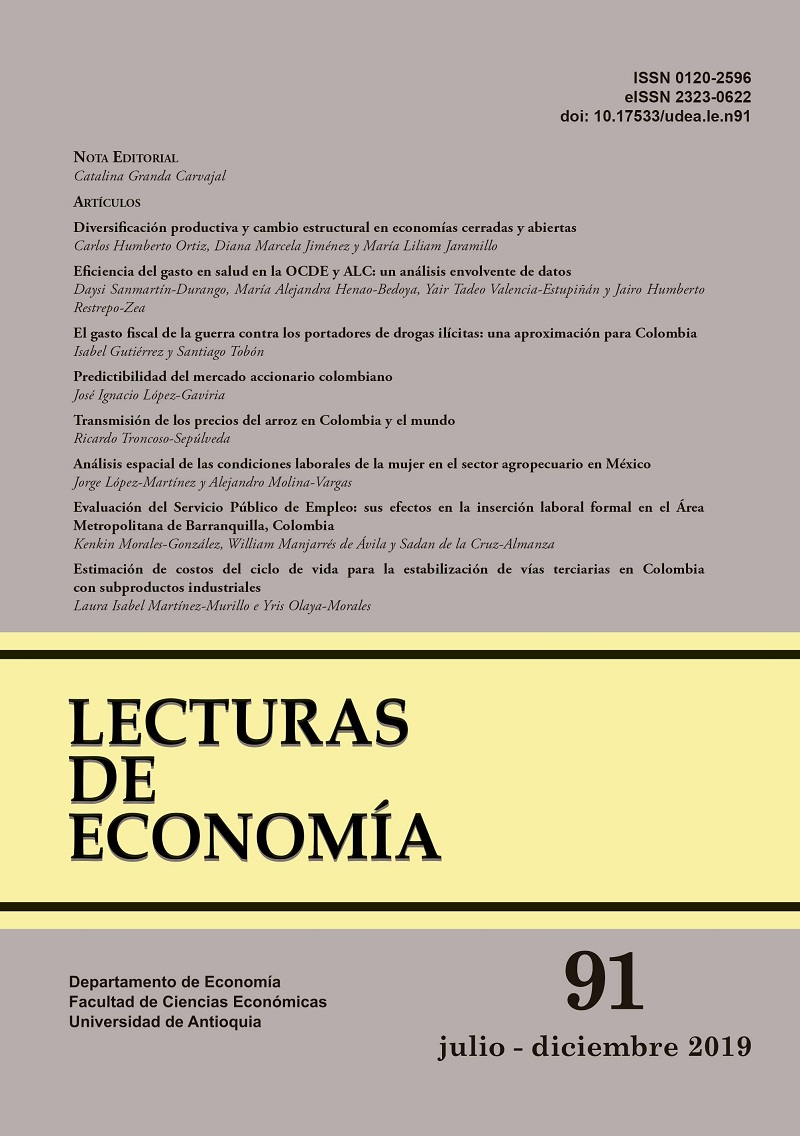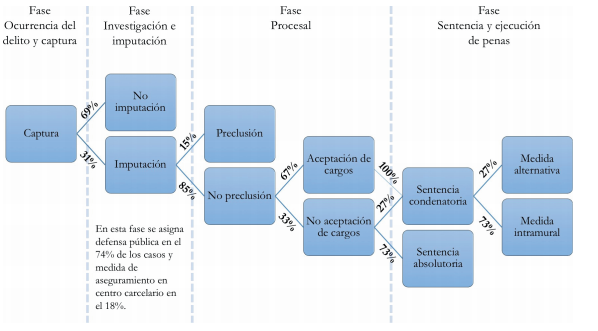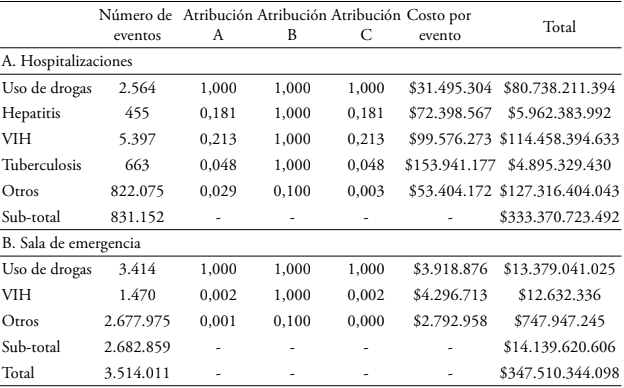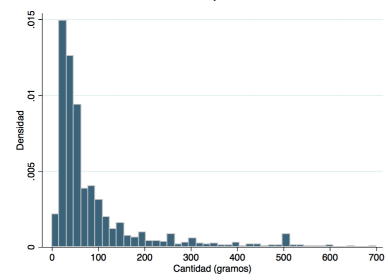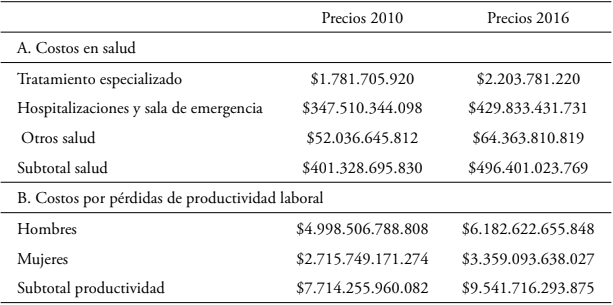El gasto fiscal de la guerra contra los portadores de drogas ilícitas: una aproximación para Colombia
DOI:
https://doi.org/10.17533/udea.le.n91a03Palabras clave:
sistema de justicia criminal, costos sociales, drogas ilícitas, gasto público, incentivos en la policíaResumen
Alrededor del mundo, los gobiernos dedican un gran volumen de recursos públicos al control del porte, fabricación y tráfico de drogas ilícitas. En general, estos costos son difíciles de observar, pues corresponden al costo de oportunidad de muchos funcionarios que intervienen en el proceso. En este artículo se estima, para el caso de Colombia, el costo esperado por captura para los delitos de porte, fabricación y tráfico de drogas ilícitas. Los resultados muestran que el costo esperado de una captura es de $11 millones, por lo que el costo esperado asociado a las 984.106 capturas realizadas entre 2001 y 2015 es cercano a los $10,6 billones. Además, se analizó si la persecución al tráfico internacional de drogas ilícitas, al crimen asociado al microtráfico en mercados locales o la disuasión a los consumidores justifican este esfuerzo fiscal. Se concluyó que ninguna de estas razones lo hace, y que más bien se relaciona con incompatibilidad de incentivos en las autoridades colombianas.
Descargas
Citas
Anderson, D. M., Hansen, B. & Rees, D. (2013). Medical Marijuana Laws, Traffic Fatalities, and Alcohol Consumption. Journal of Law and Economics, 56 (2), 333–369.
Anderson, D. M., Hansen, B. & Rees, D. (2015). Medical Marijuana Laws and Teen Marijuana Use. American Law and Economics Review, 17 (2), 495–528.
Anderson D. M, Rees, D. (2014) The legalization of recreational marijuana: how likely is the worst-case scenario? Journal of Policy Analysis and Management, 33, 221–232.
Aparicio Barrera, J. (2009). Criminalidad en cifras: delitos en Colombia, 2008. Revista Criminalidad, 51(1), 17–23.
Barco-Pérez, J. & Arana-Cosme, J. (2014). Resultados operativos de la Policía Nacional, 2013. Revista Criminalidad, 56 (2), 141–145.
Buitrago, J., Bernal, P. & Rodríguez, J. (2015). Registros administrativos de policía para la consolidación de cifras de criminalidad en Colombia. Revista Criminalidad, 57 (2), 11–22.
Buitrago, J. & Norza-Céspedes, E. (2016). Registros de la criminalidad en Colombia y actividad operativa de la Policía Nacional durante el año 2015. Revista Criminalidad, 58(2), 9–20.
Cortés, A. (2011). Análisis del sistema de defensoría pública en Colombia. Nuevos Paradigmas de las Ciencias Sociales Latinoamericanas, 2(3), 87–118.
Departamento de Justicia de Estados Unidos (2011). The Economic Impact of Illicit Drug Use on American Society. Washington, D.C.: U.S. Department of Justice, National Drug Intelligence Center.
Duarte-Velásquez, Y. (2013). Resultados operativos de la Policía Nacional, 2012. Revista Criminalidad, 55(3), 151-156.
Espino-Duque, G. (2010). Resultados operacionales y servicios de la Policía Nacional, 2009. Revista Criminalidad, 52(1), 143–148.
Goldstein, P. (1995). Drugs and Violence: Myth and Reality. En L. Joseph (Ed.), Crime, Communities and Public Policy (pp. 181–200). Chicago: University of Chicago Center for Urban Research and Policy Studies.
Hall, W. & Lynskey, M. (2016). Evaluating the public health impacts of legalizing recreational cannabis use in the United States. Addiction, 111(10), 1764–1773.
Harwood, H. J., Fountain, D. & Livermore, G. (1998). The Economic Costs of Alcohol and Drug Abuse in the United States– 1992. Rockville, MD: National Institutes on Drug Abuse. Recuperado de: https://archives.drugabuse.gov/publications/economic-costsalcohol-drug-abuse-in-united-states-1992
Harwood, H. J., Fountain, D. & Livermore, G. (1999). A report and commentaries: Cost estimates for alcohol and drug abuse. Addiction, 94(5), 631–647.
Harwood, H. J., Kallinis, S. & Liu, C. (2001). The Cost and Components of Substance Abuse Treatment. Rockville, MD: Center for Substance Abuse and Mental Health Services Administration, Department of Health and Human Services.
Harwood, H. J., Napolitano, D. M., Kristiansen, P. L. & Collins, J. L. (1984). Economic Costs to Society of Alcohol and Drug Abuse and Mental Illness: 1980. (Report No. RTI/2734/00-01FR) Recuperado de: https://www.ncjrs.gov/pdffiles1/Digitization/117820NCJRS.pdf
MacCoun, R., Pacula, R., Chriqui, J. Harris, K. & Reuter, P. (2009). Do Citizens Know Whether Their State Has Decriminalized Marijuana? Assessing the Perceptual Component of Deterrence Theory. Review of Law and Economics, 5(1), 347–371.
Ministerio de Justicia y del Derecho (2013). Análisis del ciclo criminal en el delito de tráfico, fabricación o porte de estupefacientes 2008-2012. Bogotá D.C.: Ministerio de Justicia y del Derecho, Viceministerio de Política Criminal y Justicia Restaurativa.
Norza-Céspedes, E. & Espino-Duque, G. (2011). Resultados operacionales de la Policía Nacional, 2010. Revista Criminalidad, 53(1), 151–163.
Norza-Céspedes, E. & López-Guaje, W. (2012). Resultados de la Policía Nacional en la lucha contra el crimen, 2011. Revista Criminalidad, 54(1), 161–169.
Office of National Drug Control Policy (ONDCP) (2001). The Economic Costs of Drug Abuse in the United States, 1992–1998. Recuperado de: https://www.hsdl.org/?view&did=3443
Office of National Drug Control Policy (ONDCP) (2004). The Economic Costs of Drug Abuse in the United States, 1992–2002. Recuperado de: https://www.hsdl.org/?abstract&did=454919
Rodríguez, J. F. (2008). Resultados operativos de la Policía Nacional de Colombia 1959–2007: Un efectivo mecanismo de control social del Estado. Revista Criminalidad, 50(1), 435–440.
Publicado
Cómo citar
Número
Sección
Licencia
Derechos de autor 2019 Isabel Gutiérrez, Santiago Tobón

Esta obra está bajo una licencia internacional Creative Commons Atribución-NoComercial-CompartirIgual 4.0.
Este sitio web, por Universidad de Antioquia, está licenciado bajo una Creative Commons Attribution License.
Los autores que publiquen en esta revista aceptan que conservan los derechos de autor y ceden a la revista el derecho de la primera publicación, con el trabajo registrado con una Licencia de Atribución-NoComercial-CompartirIgual de Creative Commons, que permite a terceros utilizar lo publicado siempre que mencionen su autoría y a la publicación original en esta revista.
Los autores pueden realizar acuerdos contractuales independientes y adicionales para la distribución no exclusiva de la versión del trabajo publicada en la revista (por ejemplo, incluirla en un repositorio institucional o publicarla en un libro) siempre que sea con fines no comerciales y se reconozca de manera clara y explícita que el artículo ha sido originalmente publicado en esta revista.
Se permite y recomienda a los autores publicar sus artículos en Internet (por ejemplo, en páginas institucionales o personales), ya que puede conducir a intercambios provechosos y a una mayor difusión y citación de los trabajos publicados.


